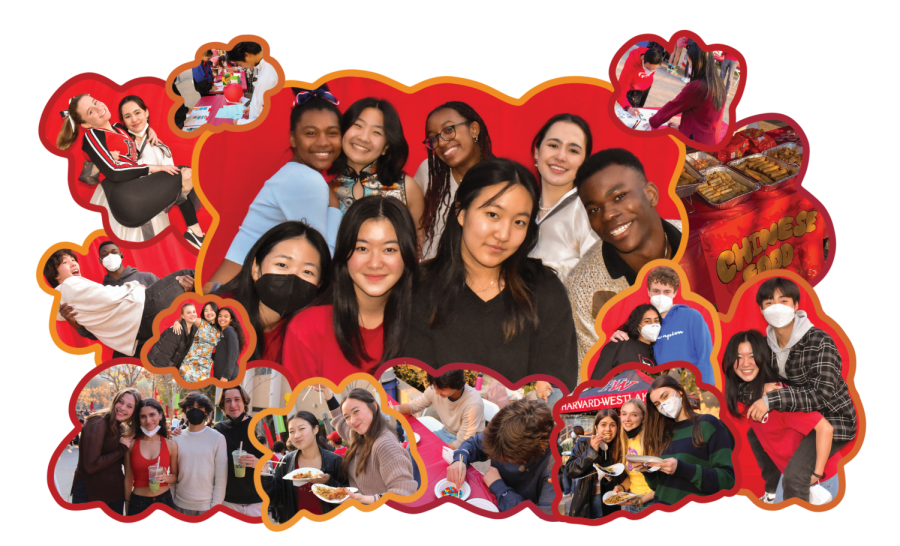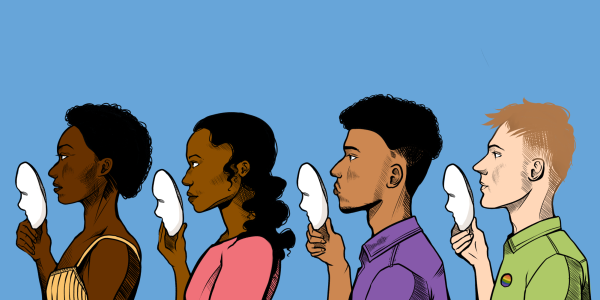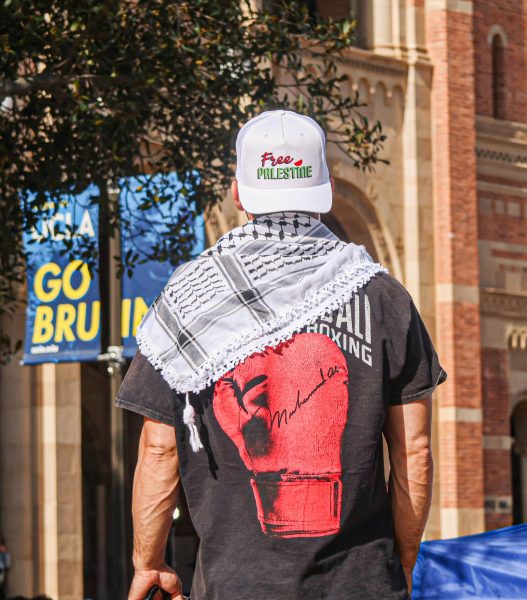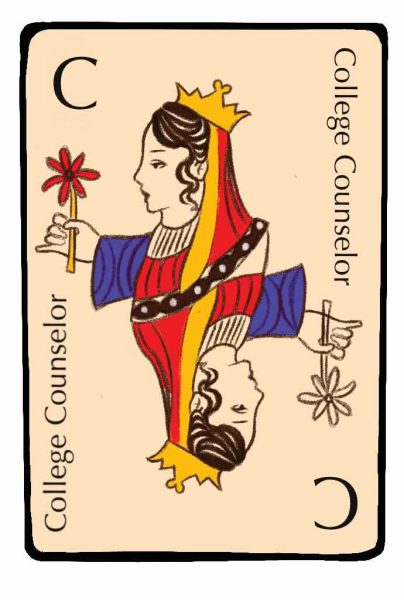Year of the Tiger: ASiA on the Prowl
School community reflects on the past and present of Asian Students in Action (ASiA), the largest affinity group on campus.
ASiA members pose for photos during New Year celebration on the quad.
February 18, 2022
Lucy Kim ’19, the founder of ASiA, describes the origins of the affinity group.
Sitting on the floor of Seaver 112 in October 2016 , Lucy Kim ’19 looked around at the 15 students who had taken note of her announcement on the school bulletin, which declared the start of a new affinity group on campus. Before that day, there had never been a formal organization for Asian students on campus. Kim said while no one had taken the initiative to start one, she had sensed her peers’ desire for a space centered on Asian American heritage at school. She contacted the administration, created a name for her club and, in her sophomore year, founded Asian Students in Action (ASiA).
“Asian American students represented a significant part of the student body, yet we didn’t have an affinity group where we could discuss our Asian American heritage,” Kim said. “I think this was partly because of the ‘model minority myth’ that expects Asians to be obedient and therefore invisible and silent in society. With ASiA, I wanted to get Asian students to feel comfortable with engaging in important dialogues concerning our unique experiences.
Kim said the club grew quickly in size and in the variety of discussion topics, which covered issues relevant to life at school and in American society.
“In the following months, the club really took off,” Kim said. “A lot more Asian students began to join our meetings and share their stories. It was exciting when people started coming to me with ideas for things to talk about and explore such as affirmative action and cultural appropriation.”
Current ASiA leaders reflect on the growth of ASiA’s membership.
Three years after that first meeting in Seaver, ASiA now has five leaders and a membership of over 200 students , consisting of both Asian American students and students of other ethnic backgrounds. Moreover, at ASiA’s recent Lunar New Year festival held Feb. 1, ASiA co-leader Annabelle Kang ’22 said over 500 members of the school community came to support the event.
Kang, who manages the club alongside Chronicle Assistant Features Editor Fallon Dern ’23, Joy Ho ’22, Julia Im ’23 and Avery Kim ’23, said she was initially nervous to take on a leadership role in such a large group.
“Although we appreciated the huge turnout, it was a bit overwhelming,” Kang said. “We were mostly concerned about how we were going to get people in such a big group to make personal connections and have the chance to share their experiences and feel like they are heard.”
Sharing Kang’s concerns, Ho said she and her fellow leaders devised a solution to ensure the accessibility of small group discussions. She said their primary goal in meetings is to create a space where all members have the opportunity to engage in discussion and reflect upon their identity as Asian Americans.
“During our meetings over the summer, we knew that we wanted to find a balance between us [leaders] talking to the members and giving the [members] a chance to open up about themselves and issues they are passionate about,” Ho said. “We decided that meetings after school would give people the most time to have intimate conversations without feeling rushed that they have to get to their next class.”
ASiA members share meaningful experiences about being part of the club.
ASiA member Patrick Yeh ’23 said he appreciates the space for after-school discussions, which provide him the opportunity to share experiences he would not typically reveal to other people.
“ASiA gives me an outlet to express feelings of discontent and discrimination,” Yeh said. “It’s a comfortable space where I can bring up topics that I usually only discuss with my family at home. It feels good to be heard and understood by my peers and [to] know that they’re going through a lot of the same things that I am.”
Like Yeh, Nyla Shelton ’24 said their reflections and the engaging topics that leaders raise have helped her achieve more self-awareness and a stronger understanding of her Asian culture.
“The leaders always have great prompts that allow everyone to participate, even if they’re not super knowledgeable in the topic, ” Shelton said. “For example, we talked about how difficult it might be to bring up mental health with our families because psychotherapy is not common in Asian households. I hadn’t thought much about the topic before, but the questions that the leaders asked us really helped me reflect on my own relationship with my family and personal connection to the issue.”
ASiA Faculty Advisor Melody Lee said she relates to the challenges of openly discussing emotions with adults and recognizes the importance of ASiA as a secure setting to work through individual conflicts.
“When I was a student, there was no organized space with guidance counselors and people you could seek out,” Lee said. “You had to fend for yourself or talk to your friends about [difficult experiences] because it was taboo to share personal issues such as mental health with your parents. A student-run organization like ASiA provides students with a safe space to talk about their issues, as they might feel more comfortable speaking to their peers and having control over the direction of the conversation.”
Lee said she values ASiA for the way it inspires students to speak freely and support each other. She said, as someone who has experienced micro-aggressions but withheld her confusion and hurt, she appreciates that ASiA encourages self-advocacy and expression of one’s truth.
“When I was around 14, I attended a track camp at Stanford, and on the first day, when my roommate’s father saw me, I knew he was upset about something having to do with me,” Lee said. “I could tell from the way he stared at me and immediately pulled his daughter out of the room that it was because I was Asian. When I overheard him say, ‘There’s no way you’re living with her,’ I understood that there are people who judge and condemn others simply because they look different. I was really hurt by his comment, but at the time, I was too young and too scared to speak up. That’s why I’m really proud of the students in ASiA who stand up for themselves and their community and share their own stories about being victims of microaggressions and racism.”
Ho said, in addition to the connections forged through meaningful discussion after school, members are united by their shared passion for anti-discrimination advocacy.
“I remember joining an ASiA Zoom call after the spa shooting in Atlanta last year and feeling very distraught,” Ho said. “I was on the brink of tears but knew that we had to do something, so we sat on Zoom for an hour discussing the goals we wanted to accomplish and how we were going to execute them. A few weeks later, we hosted the virtual school-wide discussion about anti-Asian hate crimes. It was incredible that so many people came together to support our cause. It reminded me how groups [like ASiA] can really make a difference.”
Instead of feeling powerless or overwhelmed, Shelton said the meeting inspired her to seek solutions to reduce violence towards marginalized groups.
“Seeing people who looked like me and my grandparents be victims of these terrible hate crimes made me feel really unsafe,” Shelton said. “But having that Zoom to talk about my anxiety and brainstorm ways to handle the hatred, as well as our own frustration, really helped me cope with everything that was happening around me.”
Brandon Aghnatios ’23, an active participant in ASiA and who is of Lebanese descent, also attended the anti-Asian hate crime discussion and said that meeting and the others he has since joined have helped him to understand the racism and bias his Asian American classmates have to face.
“It was heartbreaking to read about the stories in the news,” Aghnatios said. “Then, at the meeting, when I heard about the discrimination that my classmates have suffered and still experience, I felt even more strongly that I need to support them. Knowing what my friends confront on a daily basis has enabled me to become a better friend. I’m glad that I’m part of such a meaningful organization [like ASiA].”
Students and teachers discuss the recent school-wide Lunar New Year festival and their favorite parts of the event.
Shelton said she appreciates ASiA for both its meaningful discussion and its exciting cultural celebrations. Referencing the recent Lunar New Year festival on campus, Shelton said from organizing to creating artwork, she enjoyed every aspect of the gathering.
“I love how ASiA is a great combination of a safe space to talk about serious issues that are prevalent, but it’s also a place where we have a lot of fun,” Shelton said. “I had such a good time when we were planning the Lunar New Year event, painting posters and decorating the Quad. I loved working with my friends on something that is really meaningful to us and our cultural heritage.”
Chinese teacher Bin He, who was born in Qinghai, China, also said he enjoyed watching the school community come together for the celebration. He said the event reminded him of the Lunar New Year celebrations he shared with his relatives in China.
“The festival recalled my youth in China and how I celebrated the new year with my family,” He said. “I was so touched seeing students and teachers working together to make the event come to life. It [embodied] the spirit of unity and harmony that the Lunar New Year celebrates.”
Ho said she was delighted to hear the positive reaction to the festival but acknowledges that it required weeks of preparation that included designing the various booths, embellishing the quad with handmade posters and lanterns and delegating tasks to students and parents who provided food and decorations.
“Even though everyone all dedicated a lot of time and effort to planning the event, it was worth all the hard work,” Ho said. “It was so gratifying to see the entire school community coming together to enjoy the celebration, learn about Asian culture, and support ASiA. We will definitely organize more gatherings in the future to raise awareness and build unity.”
Ho said the festivity extended beyond entertainment. She said the event, as well as ASiA itself, is a statement about Asian American empowerment that inspired not only Asian students but also the entire community at school.
“The event was really empowering for us in ASiA, but it was also important for people outside of the affinity group to see our strength and pride in our Asian hertiage,” Ho said. “[ASiA] debunk the ‘model minority myth’ that say we are submissive and reserved. It allows other people to see that we are vibrant, assertive and incredibly proud of who we are.”









































